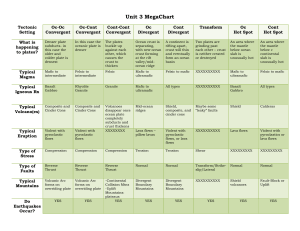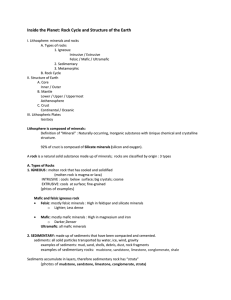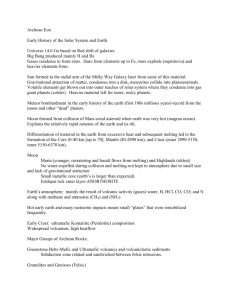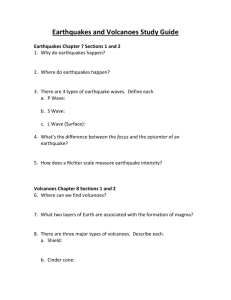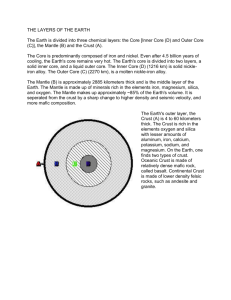Geol 101: Physical Geology
advertisement
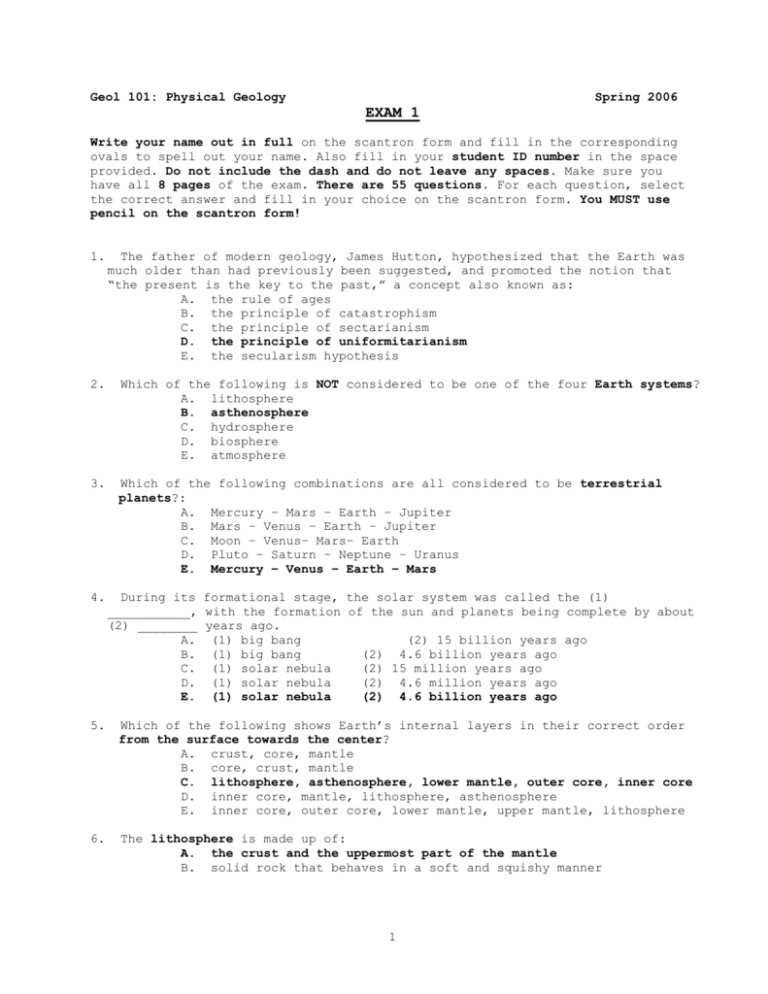
Geol 101: Physical Geology Spring 2006 EXAM 1 Write your name out in full on the scantron form and fill in the corresponding ovals to spell out your name. Also fill in your student ID number in the space provided. Do not include the dash and do not leave any spaces. Make sure you have all 8 pages of the exam. There are 55 questions. For each question, select the correct answer and fill in your choice on the scantron form. You MUST use pencil on the scantron form! 1. The father of modern geology, James Hutton, hypothesized that the Earth was much older than had previously been suggested, and promoted the notion that “the present is the key to the past,” a concept also known as: A. the rule of ages B. the principle of catastrophism C. the principle of sectarianism D. the principle of uniformitarianism E. the secularism hypothesis 2. Which of the following is NOT considered to be one of the four Earth systems? A. lithosphere B. asthenosphere C. hydrosphere D. biosphere E. atmosphere 3. Which of the following combinations are all considered to be terrestrial planets?: A. Mercury – Mars – Earth – Jupiter B. Mars – Venus – Earth – Jupiter C. Moon – Venus– Mars– Earth D. Pluto – Saturn – Neptune – Uranus E. Mercury – Venus – Earth – Mars 4. During its formational stage, the solar system was called the (1) ___________, with the formation of the sun and planets being complete by about (2) ________ years ago. A. (1) big bang (2) 15 billion years ago B. (1) big bang (2) 4.6 billion years ago C. (1) solar nebula (2) 15 million years ago D. (1) solar nebula (2) 4.6 million years ago E. (1) solar nebula (2) 4.6 billion years ago 5. Which of the following shows Earth’s internal layers in their correct order from the surface towards the center? A. crust, core, mantle B. core, crust, mantle C. lithosphere, asthenosphere, lower mantle, outer core, inner core D. inner core, mantle, lithosphere, asthenosphere E. inner core, outer core, lower mantle, upper mantle, lithosphere 6. The lithosphere is made up of: A. the crust and the uppermost part of the mantle B. solid rock that behaves in a soft and squishy manner 1 C. continental crust and oceanic crust only D. the highest density rocks of all the Earth’s internal layers E. all of the above 7. South America and Africa do not fit together perfectly when matched up across the Atlantic Ocean because: A. they were never together to begin with B. parts of the continents were long ago subducted C. their shapes have changed since Pangea broke up D. the magnetic field has changed since the breakup of the continents E. the true boundaries of the continents are actually 900m below sea level 8. Evidence that North America used to be connected to Eurasia is given by the fact that the (1) ___________ in North America match up with the (2) _________ in Eurasia when the continents are brought back together. A. (1) Rockies (2) Alps B. (1) Rockies (2) Caledonides C. (1) Appalachians (2) Alps D. (1) Appalachians (2) Caledonides E. (1) Cascades (2) Appalachians 9. Which of the following is NOT considered to be a part of Gondwana? A. Asia B. Africa C. India D. Australia E. Antarctica 10. Although Pangea’s southern Gondwana continents contain evidence of an ice age during the Carboniferous Period, there are no equivalent aged glacial deposits in the northern Laurasia continents because: A. Gondwana was near the south pole in the Carboniferous, but Laurasia was near the equator B. Laurasia was near the south pole in the Carboniferous, but Gondwana was near the equator C. the glacial deposits in Gondwana did not form in the Carboniferous after all D. Laurasia did not exist during the Carboniferous E. we haven’t looked hard enough for glacial deposits in Laurasia 11. One line of evidence that Africa and South America used to be one continent is that they both show evidence of a type of plant called: A. Cynognathus B. Glossopteris C. Tyrannosaurus D. Mesosaurus E. Alto Redwood 12. Which of the following statements about paleomagnetism at spreading ridges is TRUE? A. there is no clear paleomagnetic signal in rocks at spreading ridges B. rocks along spreading ridges show the same paleomagnetic north, no matter what their age 2 C. the paleomagnetic pattern on one side of a ridge is the mirror image of the other side of the ridge D. there is evidence that Earth’s magnetic poles reverse every 11 years or so E. the paleomagnetic characteristics of rocks next to spreading ridges are still unknown 13. The mid-Atlantic ridge is an example of a spreading ridge. As a result of the process of (1) _________ that occurs at this ridge, the oldest oceanic crust in the north Atlantic must be located (2) ____________: A. (1) seafloor spreading (2) along the ridge itself B. (1) seafloor spreading (2) along the coasts of N. America and Europe C. (1) seafloor spreading (2) with a striped pattern of repeating old and young rocks D. (1) subduction (2) along the ridge itself E. (1) subduction (2) along the coasts of N. America and Europe 14. Which of the following combinations is a correct match between (1) a type of plate boundary; and (2) a characteristic feature of that type of plate boundary? A. (1) divergent (2) subduction zone B. (1) convergent (2) transform fault C. (1) transform (2) subduction zone D. (1) transform (2) island arc E. (1) divergent (2) rift valley 15. Which of the following statements about convergent plate boundaries is TRUE? A. when two plates collide, at least one of the plates will always subduct B. the collision of oceanic crust against continental crust will result in subduction of the continent C. there are only two types of convergent boundaries: ocean-ocean and ocean-continent D. if two ocean plates collide, melting of the subducted plate creates an island arc of volcanoes E. it takes two continents colliding in order to form a volcanic arc mountain range 16. The top of Mt. Everest exhibits (1) __________ which indicates that (2) ___________. A. (1) a suture zone (2) it must be an oceancontinent plate boundary B. (1) a caldera (2) it must be a volcano C. (1) constant elevation (2) the collision between India and Asia is now complete D. (1) glacial features (2) it used to be near the south pole as part of Gondwana E. (1) sea shell fossils (2) it is made of old ocean floor that got uplifted during collision 3 17. 18. 19. 20. 21. The main driving force behind plate tectonics is (1) __________ in the mantle. Sometimes, a large plume of hot magma rises all the way to the surface, creating a (2) ___________. A. (1) convection (2) hot spot B. (1) melting (2) volcano C. (1) cooling (2) lava lamp D. (1) jets (2) Plinian column E. (1) subduction (2) chain of volcanic islands Which of the following statements about atoms is TRUE? A. atoms are only about 1 mm wide B. atoms are the smallest particles that uniquely identify an element C. different atoms of the same element always have the same number of neutrons D. the atomic number (number of protons) of an element can vary E. isotopes are different elements that have very similar atoms The negatively charged particle in an atom is a/an (1) ______; the positively charged particle is a/an (2) ______. A. (1) proton (2) electron B. (1) neuron (2) positron C. (1) electron (2) proton D. (1) negatron (2) positron E. (1) muon (2) moron An atom that gains extra _______ charge. A. (1) cation B. (1) anion C. (1) molecule D. (1) cation E. (1) anion electrons forms a/an (1) _______ with a (2) (2) (2) (2) (2) (2) positive positive positive negative negative Sodium chloride is a compound that which forms with (2) _______ bonds. A. (1) diamond (2) B. (1) table salt C. (1) sugar (2) D. (1) mica (2) E. (1) graphite (2) we usually refer to as (1) ______ and covalent (2) ionic covalent van der Waals metallic 22. The type of chemical bonding that forms the strongest bonds (e.g. in diamond) is: A. ionic B. van der Waals C. metallic D. covalent E. hydrogen 23. If “X” represents a type of cation, and “Y” represents a type of anion with an equal but opposite charge to “X”, the correct way to write out the formula of the chemical compound produced by the bonding of “X” and “Y” is: A. YX B. XY 4 C. D. E. 24. 25. Y2X X2Y dependent on which atom is bigger Which of the following statements about minerals is TRUE? A. whenever elements comes together in a specific ratio, a mineral is formed B. water and ice are both minerals C. all minerals have a characteristic organized internal atomic structure D. all minerals must have more than one element in their chemical formula E. glass is a mineral Which of the following minerals can also be characterized as a native element?: A. silica B. ice C. phlogopite mica D. feldspar E. graphite 26. The two most abundant elements, comprising about 84% of all the atoms in the Earth’s crust, are: A. silicon and aluminum B. chlorine and sodium C. hydrogen and helium D. iron and oxygen E. oxygen and silicon 27. 28. The process of atomic substitution in a mineral is when impurity atoms substitute for similar sized atoms in the crystal lattice during growth of the mineral. The property of the mineral that is altered as a result is the: A. hardness B. color C. crystal shape D. cleavage E. density The softest mineral on the Mohs Hardness Scale is: A. quartz B. calcite C. gypsum D. talc E. diamond 29. The most abundant mineral family is the (1) ________ and the second-most abundant is the (2) _______: A. (1) silicates (2) oxides B. (1) oxides (2) silicates C. (1) carbonates (2) oxides D. (1) nonsilicates (2) silicates E. (1) silicates (2) carbonates 5 30. The silica _________. A. B. C. D. E. anion contains (1) _______ arranged into a shape called a (2) (1) (1) (1) (1) (1) one silicon and one oxygen four silicons and one oxygen four silicons and four oxygens one silicon and four oxygens one silicon and four oxygens (2) (2) (2) (2) (2) silicate pyramid tetrahedron tetrahedron pyramid 31. Which of the following silicate minerals has an atomic arrangement in the form of sheets? A. plagioclase B. olivine C. table salt D. quartz E. mica 32. 33. Which of the following is NOT a ferromagnesian silicate?: A. plagioclase feldspar B. garnet C. biotite mica D. pyroxene E. olivine Metals occur in the Earth as ore minerals, often in the form of sulfides, such as the so-called fool’s gold (FeS2), which is more accurately called: A. native gold B. hematite C. pyrite D. galena E. magnetite 34. Minerals can NOT form by the following process: A. crystallization of magma or lava B. by hydrothermal processes C. the alteration of existing minerals D. growth of bones in living organisms E. evaporation 35. On average, the geothermal gradient inside the Earth is about: A. 1000°C per kilometer B. 100°C per kilometer C. 50°C per kilometer D. 25°C per kilometer E. 10°C per kilometer 36. The inside of the earth is not completely molten (i.e. liquid) because: A. it never gets hot enough to melt rocks deep in the earth B. the melting temperature of rocks increases as pressure increases C. its chemistry always causes it to be a solid with the consistency of salt water taffy D. the earth would collapse in on itself if it were E. none of the above because the inside of the earth is completely molten 6 37. The different types of magma, in order from lowest to highest silica content, are: A. felsic, intermediate, mafic, ultramafic B. felsic, mafic, intermediate, ultramafic C. mafic, ultramafic, intermediate, felsic D. ultramafic, mafic, felsic, intermediate E. ultramafic, mafic, intermediate, felsic 38. 39. Which of the following types of lava has the lowest viscosity and therefore flows the fastest and furthest? A. felsic B. intermediate C. mafic D. magma E. ketchup When lava erupts and cools, if may form a groundmass of small crystals occurring together with larger phenocrysts that grew in the magma while it was still inside the Earth. The resultant type of igneous rock texture is called: A. aphanitic B. phaneritic C. porphyritic D. pyroclastic E. pegmatitic 40. Which of the following list of minerals is in the correct crystallization order according to Bowen’s Reaction Series (note that not all possible minerals in the series are shown)? A. Na-plagioclase, Ca-plagioclase, K-feldspar, quartz B. amphibole, Ca-plagioclase, K-feldspar, muscovite mica C. olivine, quartz, muscovite mica, amphibole D. olivine, pyroxene, amphibole, biotite mica E. quartz, muscovite mica, K-feldspar, Na-plagioclase 41. Which of the following lists of igneous rocks contain rock types that belong together in the same group? A. basalt; andesite; rhyolite B. basalt; gabbro; diorite C. gabbro; diorite; dacite D. granite; diorite; basalt E. granite; andesite; rhyolite 42. How many active volcanoes are there in the world? A. about a million B. around 10,000 C. around 1,500 D. around 800 E. less than 100 43. The type of volcanic hazard that involves a mudflow made of ash is called a: A. lahar B. tsunami 7 C. D. E. pyroclastic flow debris avalanche ash fall 44. Which of the following combinations is NOT a correct match of a volcanic hazard and a corresponding example? A. ejected lava bombs (e.g., Galeras, Colombia) B. pyroclastic flow (e.g., Pompeii in AD 79) C lava flow (e.g., Goma, Democratic Republic of Congo) D. lahar (e.g., Armero, Colombia in 1985) E. toxic gas cloud (e.g., Kilauea, Hawaii) 45. Which of the following is NOT a characteristic of a nonexplosive eruption? A. shield volcano B. low-viscosity lava C. typically mafic lava D. Plinian column E. examples in Hawaii, Iceland and Galapagos 46. Volcanoes with steep slopes that form from the accumulation of viscous lava and pyroclastic flows are: A. shield volcanoes B. stratovolcanoes C. composite volcanoes D. both A and B above E. both B and C above 47. An explosive eruption that causes the top of a volcano to collapse into the underlying empty magma chamber creates a large circular hole in the volcano called a: A. caldera B. crater C. lava dome D. cinder cone E. maar crater 48. The most active volcano in the known eruption that occurred in __________. A. (1) Crater Lake B. (1) Mt. St. Helens C. (1) Mt. St. Helens D. (1) Mt. Mazama E. (1) Mt. Shasta 49. Cascades is (1) __________ but the largest pre-historic times was the eruption of (2) (2) Mt. St. Helens (2) Lassen Peak (2) Mt. Mazama (2) Mt. Tehama (2) Mt. St. Helens Which western US volcano last erupted about 70,000 years ago? A. Mount Mazama B. Mount Rainier C. Mount Hood D. Craters of the Moon E. Yellowstone 50. Which of the following features were NOT produced when Mount St. Helens erupted in 1980? 8 A. B. C. D. E. lahar lateral blast pahoehoe lava flows pyroclastic flow Plinian column BONUS QUESTIONS 51. Which of the following can be rearranged to spell the name of a mineral which dissolves readily in diluted hydrochloric acid? A. cami B. lite mood C. freds pal D. ice talc E. i no vile 52. What does the atomic model on the right represent? A. diamond B. graphite C. quartz D. the silica anion E. DNA structure 53. What do we A. B. C. D. E. 54. The world’s largest lava dome is: A. Lassen Peak, California B. Mount St. Helens, Washington C. Craters of the Moon, Idaho D. Yellowstone, Wyoming E. Mauna Loa, Hawai’i 55. call mafic lava that is smooth and syrupy? magma pahoehoe a’a spatter cinders I have made sure that my name and student ID number are correctly filled in on the scantron sheet and I will remember to hand in the scantron sheet and take the test question sheet with me when I leave. I will check my grade on the WebCT website. A. yes B. no C. 42 9
